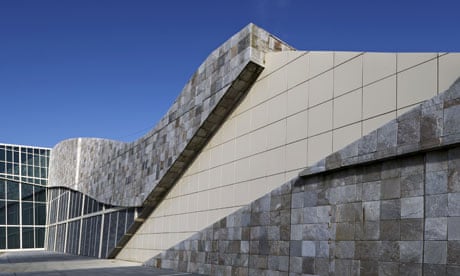Spain's latest architectural extravagance was finally opened to the public today amid complaints that the massive new City of Culture in Santiago de Compostela is a huge and expensive white elephant.
American architect Peter Eisenman describes his €400m (£332m) hilltop complex overlooking one of Spain's most picturesque and historic cities as something that is meant to appear as though it has "erupted and heaved up" from the ground.
But others see the complex of six buildings in Galicia as a monument to the vanity of the region's former rightwing premier, Manuel Fraga, and an anachronism at a time of austerity. The project, still only half-built, has already cost four times more than originally planned.
"It was born in the Spain of excess and is opening during an economic collapse, as a sort of monument to construction bubble," said columnist Anxo Luxilde in La Vanguardia newspaper.
Two of the six buildings – a library and a newspaper archive – were opened today, 12 years after the project was first commisioned during Fraga's term in office. They will eventually be joined by a 2,000-seat theatre, a museum of Galician history and an international arts centre. A sixth building will house services for the other five.
The Galician region's current premier, Alberto Núñez Feijóo, from the same People's party as Fraga, today compared the buildings to New York's Museum of Modern Art and the Sydney Opera House. "There is now another obligatory stop on the main itineraries of the world," he said.
Building of the theatre and arts centre has yet to be started and questions are already being asked about whether there will be money to fill galleries with art or attract audiences.
The regional government has decided to slow construction further. Culture chief Roberto Varela said the theatre building would not be started for another three years. The international arts centre, meanwhile, may have to be converted into offices.
"We inherited this project in a very advanced state. We had no other option but to continue with it," Varela said. The "spectacular and marvellous" museum of Galicia would open next year, he said.
"It is a cemetery for money," complained Pedro Armas, a spokesman for the opposition socialist party in the nearby city of La Coruña, where the budget for the Galician Symphony Orchestra has just been slashed.
The buildings are set by an arboretum on a 173-acre site on Mount Gaiás with curved roofs that appear to open out on the hill overlooking a city that is one of Europe's main centres of Catholic pilgrimage.
Eisenman said the project could only be compared in scale to the Getty Centre in Los Angeles. "And that took 15 years to complete," he told the Faro de Vigo newspaper. "The size of the project has been increased several times over the past 10 years, so it is not surprising that the costs have increased.
"The scale and the ambition of the job probably make the City of Culture unique in the world. There is no way that it can be considered a waste of money. It is a serious investment in the welfare of Galicia and of future generations."
The computer-generated design saw Eisenman superimpose a map of the old city's streets on to the surface of Mount Gaiás, using software to adapt it to the hill's contours. The centre's curved roofs were partly inspired by the scallop shell traditionally carried by pilgrims to the shrine of St James in the city's cathedral.
Critics complain that the whole project reflects a state of mind that saw signature cultural buildings such as Bilbao's Guggenheim Museum rise in cities across the country during an economic bonanza. Such buildings, they say, are now inappropriate in a country with 20% unemployment and a 9% budget deficit.
A similar, if much smaller, cultural centre designed by Oscar Niemeyer, the 103-year-old Brazilian architect, will open shortly in the northern town of Avilés.
Fraga, a former minister in the dictator General Francisco Franco's governments, was regional premier of Galicia from 1990 until 2005.

Comments (…)
Sign in or create your Guardian account to join the discussion